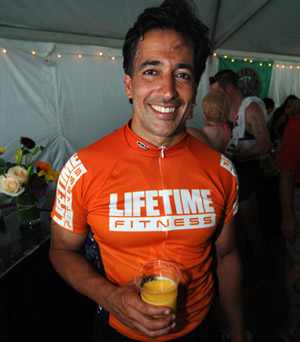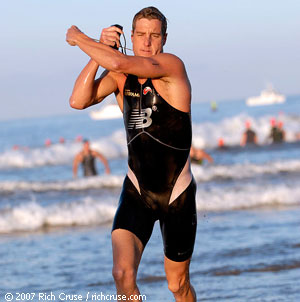The Life Time Fitness Series
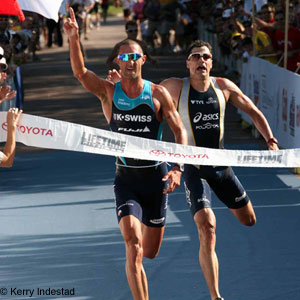
In its 35 years of existence, triathlon’s emergence as a professional sport which could sustain the careers of an elite class might be charted like those illustrations in evolution textbooks. You remember, they featured a progression from fish coming on land, four legged dinosaurs, apes propelling themselves with hands and feet, bent over Neanderthals, to erect men. And triathlon’s initial emergence as a workout to spice up the monotony of bored runners and the epic amateur challenge of the Ironman has its own subsequent professional evolutionary landmarks.
A rough sketch of this monetary evolution might start with the short course United States Triathlon Series which offered real prize money (average winner’s payout of $5,000 to $8,000) starting in late 1982 and encouraged excellent athletes to make a career of the fledgling sport. Next up was the IMG-owned Nice Triathlon begun in 1983 which offered excellent prize money and a well-produced network TV show which by 1985 lured the cream of the sport away from Hawaii.
In 1986, Ironman Hawaii responded, thanks to an anonymous donation, offered a $100,000 prize purse to regain its primacy in prestige and importance. By the early 1990s, the Zofingen Powerman Duathlon also posed a rivalry to the primacy of Kona by offering a $200,000 prize purse and the largest winner’s payoff. In 1994, Maddie Tormoen earned the biggest payday in triathlon history with her $50,000 check at Zofingen for winning the women’s title and finishing ahead of the men in a gender handicap format. That check dwarfed the winners of the 1993 Ironman, who took home $20,000.
But the next step up the economic ladder was the inspiration of Bahram Akradi, who put up a $50,000 payoff for the winner of his inaugural Lifetime Fitness Triathlon in 2002. The next year he upped the ante considerably by putting up a $200,000 payout to the overall winner of the gender handicapped combined elite category, and $50,000 for the winner of both genders, as part of a $500,000 overall purse.
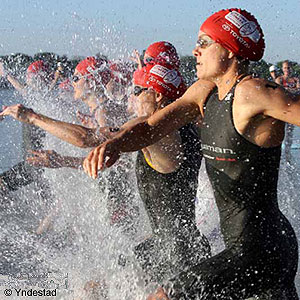
Those payoffs dwarfed the winner’s payout for the ITU’s world championship through 2010, which offers $35,000 to the winners of this year’s Grand Final and a $55,000 bonus for winning the overall World Championship title that comes with victory in the season’s points chase.
By 2007, Ironman Hawaii had upped its payout to $110,000 for the winners and $560,000 total purse. But the biggest splash was made by the Iowa-based Hy-Vee grocery chain which followed in the footsteps of Akradi’s Lifetime Fitness big prize purses with their twin $200,000 payouts to its men’s and women’s winners and, by 2009, a $1 million total purse.
Certainly 2007 was a high water mark in the rise of triathlon as a professional sport as Lifetime Fitness made another big innovation in triathlon prize money. While it slightly reduced the payout of its flagship Minneapolis event to $60,000 for the winners and abandoned the gender handicapped bonus, it offered another $60,000 for the winner of the series finale, the Toyota US Open in Dallas, and a $60,000 bonus for the winners of the series. But capping it all off was a $300,000 bonus for winning all four of the series races – which led to a groundbreaking total $500,000-plus payout to Greg Bennett for achieving the 2007 Lifetime grand slam.
In terms of drama, seen on TV broadcasts of the first Lifetime Fitness races, Barb Lindquist’s near collapse victory under lightning-streaked, charcoal-dark, pouring-rain skies in 2002, set the standard which was met time and again at Lifetime Fitness in Minneapolis by great performers reaching for the one purse in the sport which offered a commensurate reward for their talents.
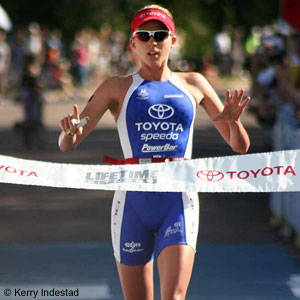
Lindquist, who won the first two Lifetime events in 2002 and 2003, says the money changed her life and “really raised the level of prestige for our sport at that time with purses of that magnitude. [Bahram Akradi] loved our sport and thought triathletes deserved better. It especially helped the sport of Olympic distance racing gain recognition. Prior to Lifetime when you said you were a triathlete people always asked "Do you do Ironman?"
Greg Bennett agrees wholeheartedly. “The Lifetime Fitness Minneapolis event is approaching 10 years and the Toyota Cup Series that grew out of it is about to start series number 5. It has attracted most of the big names in the sport at various times. It's offered prize purses bigger than the very biggest prize purses in the world of professional triathlon. And it set a standard that Hy-Vee stepped up to the plate to meet and ultimately exceed.”
Back in the heady days of its spectacular first six years, the Lifetime Fitness race in Minneapolis and its big purses and elite invitation fields achieved prestige and pull on par with the ITU world championship. The roll of winners included all-time greats Emma Snowsill (3x) Simon Whitfield (2x), Barb Lindquist (2x) Craig Walton (2x), Greg Bennett, Matt Reed, Craig Alexander, Hunter Kemper, Vanessa Fernandes, Loretta Harrop and Sarah Haskins (2x). The races drew many other greats like Olympic champion Hamish Carter, ITU Word titlists Tim Don, Bevan Docherty and Chris McCormack, and stars like Andy Potts, Rasmus Henning; not to forget top women like Julie Dibens, Mirinda Carfrae, Laura Bennett, Becky Lavelle, Samantha McGlone, Leanda Cave and Joanna Zeiger.
The Lifetime Fitness and Toyota Cup races were top drawer, appointment triathlon and at its peak started give great Olympic distance triathletes a national recognition factor and a sustainable fan base.
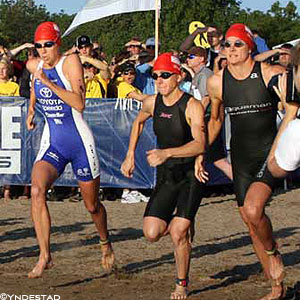
Since then, a spectacular economic downturn has hit even the most recession proof sport of triathlon – and Lifetime Fitness, in conjunction with its signature sponsor Toyota, has been adapting.
Cut to 2010 and a very different picture emerges at the Lifetime Fitness triathlon and the six-event Race to the Toyota Cup series. At Minneapolis, with a still attractive but not overwhelming $20,000 on the line for a win (one-tenth of the winner’s take from 2003 through 2005) and $92,000 total prize money (one-fifth of the 2003-2005 Lifetime Fitness purses) the men’s field in Minneapolis had but four internationally renowned men, and three U.S. up and comers who race well in non drafting events. The women’s field had a similar mix – headliner Sarah Haskins, four excellent U.S. performers but no current Euro or Australian ITU stars.
The contrast with the heyday of the Lifetime / Toyota Cup series was more dramatic at the New York City Triathlon. With but a $31,000 total purse paid 5 deep with $8,000 to the winner, New York offered a battle between former Czech ITU journeyman Filip Ospaly and perennial US non drafting contender David Thompson in the men’s race, and a duel between the talented and admirable but not-yet marquee Wassner twins Rebeccah and Laurel..
While the Beatles knew that money can’t buy me love, the more modest, belt-tightening payouts are making the pro fields at Lifetime-Toyota Cup series events thinner. With the series is facing competition from the ambitiously funded Rev3 races, an expanded menu of ITU World Championship Series and World Cup races, and a raft of Ironman 70.3 contests that tempt many of the faster short-course performers, a question arises: Was the Lifetime Fitness business model for its lowest prize money events – New York and Philadelphia with $31,000 purses and Los Angeles with a $40,000 purse – heading toward the design of the successful Rock and Roll Marathons? That is, were they accepting second-tier pro participation in return for short term profits with first tier, sold-out mass participation events?
Lifetime Fitness CEO Bahram Akradi, the man who bet big on game-changing purses at triathlons, said that comparison was not valid.
“Triathlon by its nature is more difficult to produce than a run,” he said. “A run can have 30,000 people on a course a lot easier than a triathlon where race directors have to organize and execute a swim, transitions, and bike and run courses. As the course gets longer with a triathlon it gets more difficult as you have to cover more distance with police and road closures. As I think through it, Competitor has done a great job with their half marathon and full marathon series. My hat's off to them.”
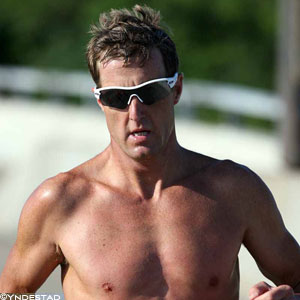
Akradi says that another comparison with the sprint series launched by Ironman and CGI are also not applicable. “The sprint distance triathlons are not at all like a pro race,” he said. “Really, they focus on participation. What we have done and will continue to deliver is a great experience for the participants where we give them an opportunity to race along side of the pros.”
Akradi still believes in his original premise. “I wanted to create a venue for the athletes so the sport of triathlon could become, for some of the athletes, an opportunity to just be athletes for a while and not require the helping of a rich relative and side job to maintain professional level of performance. Life Time Fitness and Toyota have done a nice job in the past 5 years to create that.”
But after five years of heroic support, Akradi understandably decided that other sponsors and race promoters should “jump in and support that same idea. I hope that triathlon series partners will come in with $60-$70-$80,000 prize purses for the pros.”
Given that, Akradi admits at this time he cannot do it alone and he cannot force every race in the series to meet his standards.
“I don’t have a demand,” he says of his partnerships with Philadelphia, New York, Chicago and Los Angeles. “We do not control the sport. We only do what we can to help it grow. I would like to see these partners to put in at least a $60,000 purse going forward on any races which are part of the series. We will ask for that but we won’t make it a mandatory condition — at this point.”
Jan Caille, the long time race director-promoter of the Chicago Triathlon, who sold ownership of his Capri Events to Lifetime but still works with them for long term strategic planning, agrees with Akradi on this point. “We wish every race in the series could offer $100,000,” says Caille. “But right now we are looking at other ways to enhance the pro athletes’ experience.”
Caille says that the equation to reach sponsorship growth and media excitement is a complicated one and the answer varies from city to city. “I get a call from [New York City Triathlon race promoter-director] John Korff, I will tell him what I think. But the New York experience is so much of the equation. Race any pro race and you have to ask yourself ‘What’s the attraction for the media?’ A pro race in New York City maybe the dogs swim, people run around in their underwear, the finish is in Central Park. It is not the same animal as Chicago or Dallas or LA. What goes on in New York is an incredible experience even without the pros. It would be great to have an even better pro field there to have more competition, more athletes and more prize money. But it is a business decision. Life Time Fitness can urge the race directors to make an adjustment to their prize purse. But right now it is up to John Korff. When you do what he does as successfully as he does for every event he produces – from tennis to other festivals — he is not a triathlon guy per se. But he puts on a kick ass triathlon and other events and we highly respect his counsel.”
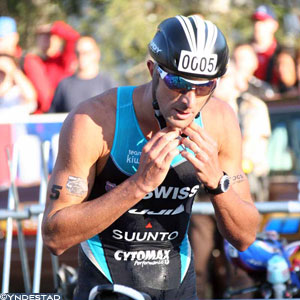
Some of the Lifetime Fitness star athletes are very understanding of Akradi’s plight and still find the races desirable—if not essential. Hunter Kemper, who won the $200,000 top prize at Minneapolis in 2005, says that current bottom tier race purses, given the economy, are “fair. I’m OK with it. But I’d go after creative race directors and promoters who are passionate about the sport. They should choose race directors who like to have pros and feel strongly they need pros to get marketing dollars. If the prize money is not there now, perhaps they can be creative in finding ways to brings pros in and give them hotel stays.”
Greg Bennett says, “Lifetime Fitness and their current series sponsor Toyota have stuck with the sport and wanted to contribute to the sport more than any other sponsor in the history of triathlon. Lifetime Fitness in the whole scheme of things is not a massive company but they are passionate about what they do.”
What Lifetime did, and Toyota continues to do, said Bennett, “was fill a void that was left after the ITU series went draft legal. It kept Olympic distance non-drafting alive and well. It has given athletes the option of ITU/Olympics, long events and my favorite—non-drafting Olympic distance.”
For his part, Akradi no longer insists that his events remain as pure, non-drafting alternatives to the ITU style. “Frankly I do not care about whether they are drafting or non drafting racing. I do not make a big deal about the draft or non drafting. Hy-Vee does drafting races. It is just a different style. If you are a tennis player, you play hard court, grass court and clay court events. To bicker about that is juvenile behavior.”
Barb Lindquist sees a more crowded international schedule as a hurdle and offers some ideas that may make it thrive again. “It is tough now,” she said. “If you want to do two series like the ITU premier events and the Toyota series you have to make sure the races don’t overlap. I am not sure if you can do both. Certainly training for two series can complement each other, but it’s tough with that much traveling.”
Lindquist senses that Lifetime and Toyota could be in need to look to the past for some needed innovation. “I would love to see experiments with format. When I raced the Formula 1 series in Australia, [which featured very short course legs not unlike the ITU world team championships] we raced hard and frankly racing that series gave me the success in ITU racing where I learned to be explosive, powerful and strong. Those races were exciting and good development races. I’d like to see some race directors think outside the box, fun for the athletes.”
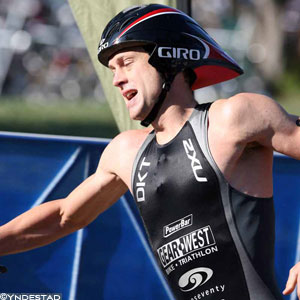
Caille offers some of the strongest arguments for supporting the status of triathlon professionals.
“The pros are essential,” said Caille. “The only way the sport will ultimately succeed in the long term is for the media to be excited about what’s going on. That will not be an age group race. The media will come out more for the 50 pros in the race, not for the age groupers. The media will enjoy and do personal stories about athletes who overcome hardships disabilities to be part of this sport. But it all boils down to what it takes to make the event newsworthy and exciting.”
And the essential draw, says Caille, cannot be only up close and inspirational personal stories of age group heroes. “If you are in a major market and inconvenience people in LA, Chicago and Philly, the event needs to be exciting with great pros so the media can get excited to showcase the race locally, regionally and nationally,” said Caille. “Bahram’s vision that spectators and media will get excited about triathlon will not happen in big cities without pros and a good show at the front.”
Still, says Caille, while prize money remains an essential ingredient in growing the sport, its relationship to the bottom line—plus and minus—retains a conservative cast in this economy. “Typically prize money goes up with our budgets,” said Caille. “The race budget is built on a formula which is a projection of sponsorship and entry fees. We are trapped and, with the exception of a few races, we do not feel we can increase entry fees. So we are locked into the current level of prize money.”
Caille feels bad about the pros who are scratching to make a living. “I think what’s sad is it’s tough for pros to make a living and that is seemingly tougher today,” said Caille. “A lot of them race in Europe for not huge prize purses either but they are drawn by the Olympic standard. The fact is that Chicago had a $25,000 purse 20 years ago, then went to $40.000 about 15 years ago and now it is $67,000. Which is nothing. You say it is one of the leading lights in our sport today and that is sad, isn’t it? But again, it’s just where the economy is.”
For anyone worried that Lifetime Fitness and it’s partners at Toyota are looking for a way out, Akradi say that while the series is tightening its belt on many fronts, it is looking forward to immediate growth. “We have added the City of Philadelphia Triathlon to our group this year,” he said. “As time goes on, I would like to add the Columbia (Maryland) Triathlon and add more quality events to expand the length and duration of the annual series.”
Far from thinking pros are irrelevant, Caille sees the pros and their talent and charisma as the answer. “Triathletes are great as athletes but they are also damn charming,” he says. “You can ask who won the Chicago Marathon? Nobody knows who these people are. They are obviously superb athletes. But triathlon pros in our series are bright, well spoken and attractive. When they do get camera time, they actually have something to say. It is a matter of figuring out formulas to make the best use of their time for their sake and the sport’s sake and the event’s sake.”


